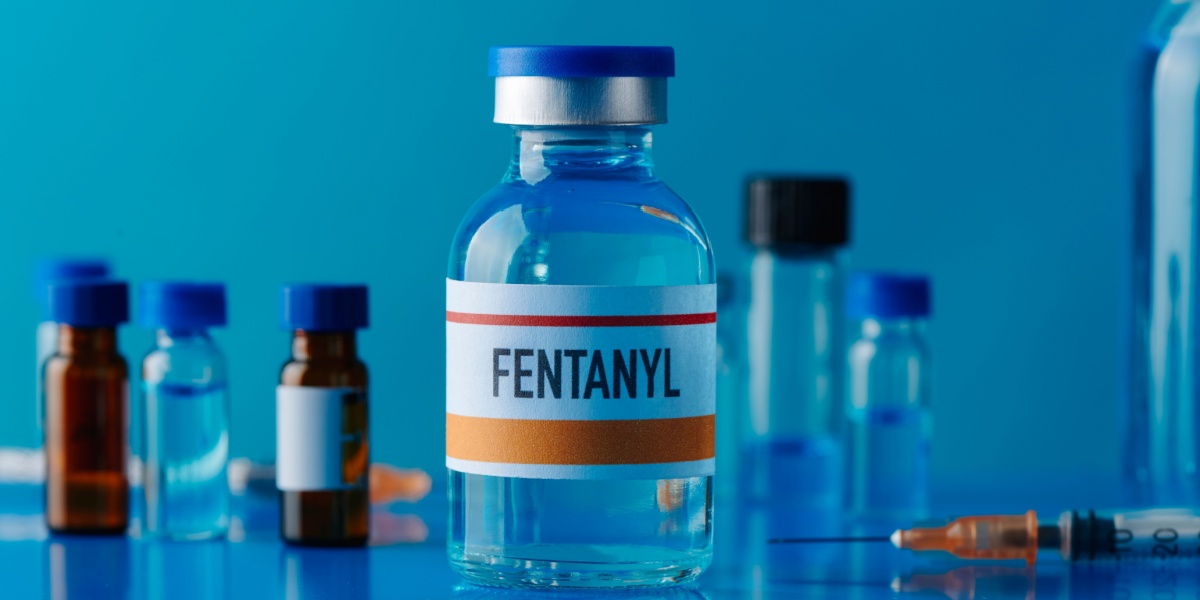Fentanyl use is becoming increasingly common, both by choice and by accident, when it has been unknowingly combined with other drugs. Because of its high potency, the increase in fentanyl use has led to a dramatic rise in the number of fatal overdoses every year.[1][2]
Understanding how fentanyl interacts with other drugs can help you make informed decisions about drug use.
- Fentanyl is an extremely potent synthetic opioid and is 50-100 times stronger than morphine.
- Around 80% of fentanyl overdose deaths involve other drugs, including other opioids, stimulants, prescription drugs, or alcohol.[3]
- Harm reduction strategies, such as carrying naloxone and testing drugs for fentanyl, can help reduce your risk of overdose.

How fentanyl interacts with other substances
Fentanyl is an exceptionally strong opioid, estimated to be 50 to 100 times more potent than morphine and 30 to 50 times stronger than heroin.[1] This strength means that you can overdose on a very small amount of fentanyl.
Fentanyl leads to reduced activity in the central nervous system (CNS depression). This causes reductions in your heart rate, blood pressure, and breathing. One of the most serious and life-threatening consequences of a fentanyl overdose is respiratory arrest, where breathing slows down significantly or stops altogether. Taking fentanyl with any other medications that affect your central nervous system or breathing can greatly increase the risk of overdose.
Fentanyl interactions with other substances
Fentanyl can interact dangerously with a wide range of substances, both legal and illicit. These interactions often amplify the effects of each drug in unpredictable ways, especially when fentanyl is combined with other central nervous system (CNS) depressants like alcohol, benzodiazepines, or opioids.
Below, we explore how fentanyl affects and interacts with commonly used substances and the serious risks these combinations can pose.
Mixing fentanyl and other opioids
Effects
Fentanyl produces effects similar to those of other opioids by acting on the same receptors in the brain. [1] However, due to its significantly higher potency, concurrent use of fentanyl with other opioids such as heroin or oxycodone can result in an unexpectedly intensified effect, equivalent to administering a substantially larger dose. This heightened potency poses a serious risk, particularly when individuals are unaware that their substances contain fentanyl.
Risks
Because fentanyl works on the same parts of the brain as other opioids, taking them together acts as if you have taken a very large dose. This significantly increases the risk of overdose.
Mixing fentanyl and stimulants
Effects
Mixing opioids with stimulants has a long history. Combining heroin and cocaine (commonly known as a speedball) can maximize the highs of each drug while minimizing some of the more negative effects. Stimulants can make you feel more alert, counteracting some of the sedative effects of opioids.[5]
Risks
By increasing your heart rate and respiration, stimulants can temporarily mask some of the effects of fentanyl. This can make it harder to judge the strength of the dose you have taken or to spot the early signs of overdose. Importantly, although stimulants may make you feel less sedated, they increase, rather than reduce, the risk of overdose.[6]
Fentanyl is also found as a contaminant in stimulants, including cocaine and methamphetamines.[7] Taking stimulants laced with fentanyl at the same time as deliberately taking fentanyl or other opioids increases your risk of overdose.
Mixing fentanyl and marijuana
Effects
Taking opioids, such as fentanyl, and marijuana together can increase the pain-killing effects of both drugs, giving a greater effect than either substance alone.[9] Marijuana can also reduce the withdrawal effects of reducing opioid use.[10]
Risks
Both marijuana and fentanyl act as CNS depressants. This means that they reduce activity in key areas of the brain, and can reduce your heart rate, blood pressure, and breathing. Taking marijuana with fentanyl increases the risk of respiratory depression (slowed breathing), which can be fatal.[8]
Mixing fentanyl and alcohol
Effects
People take both alcohol and opioids to reduce pain and feel more relaxed. Taking both together can increase those effects beyond those you would expect from either substance in isolation.[11]
Risks
Both of these substances are CNS depressants and can cause sedation. Taking them at the same time can lead to increased sedation, unconsciousness, coma, and slowing of the respiratory and cardiac rates. This can include respiratory and/or cardiac arrest, which can be fatal.[8]
Mixing fentanyl and benzodiazepines
Effects
Taking benzodiazepines (benzos) at the same time as fentanyl can intensify the feeling of ‘high’ you get from opioids.[13]
Risks
Both benzodiazepines and fentanyl are CNS depressants. Taking the two together increases the risk that you might suffer respiratory depression, which can be fatal.[12]
Fentanyl and prescription medications (antidepressants, antipsychotics, sleep aids
Effects
Other prescription medications, such as antidepressants, antipsychotics, or sleep aids, can also interact with fentanyl. These are usually not taken for their pleasurable effects. Instead, they are used to treat other conditions you may have, such as depression.
Risks
As with other drugs in this list, many prescription drugs act as CNS depressants and can cause sedation. When they are taken with fentanyl, they can increase the risk of respiratory depression and, potentially, death. Additionally, some of these medications act as vasodilators, relaxing the heart. Medications such as clonidine can cause brachycardia (slowed heart rate), which further increases the risks of fentanyl.
Some antidepressants, such as selective serotonin reuptake inhibitors (SSRIs) like citalopram, fluoxetine, and sertraline, can interact with fentanyl to increase the risk of serotonin syndrome. This can cause fever, seizures, unconsciousness, and can be fatal.
Fentanyl harm reduction strategies
The main harm reduction strategies to minimize the risks of fentanyl interactions when combining different drugs include using fentanyl test strips, having naloxone available, and avoiding using drugs when alone—that is, ensuring you are in the presence of someone who can assist in case of an emergency.
Testing for fentanyl presence
Fentanyl test strips can detect whether your drugs—whether opioids, stimulants, or benzodiazepines—contain fentanyl before use. [4] If the test is positive, you should discard the substance safely and thoroughly to avoid further contamination.
Reducing risk when mixing substances:
- Stimulants: If your stimulants test positive for fentanyl, consider adjusting your use and ensure someone knowledgeable about overdose signs and naloxone administration is nearby.
- Marijuana: When using marijuana alongside fentanyl, try to separate their use when possible. If used together, reduce your fentanyl dose and have someone present to monitor your breathing and overall condition.
- Alcohol: Avoid consuming alcohol until the effects of fentanyl or other opioids have fully worn off. If you do combine them, ask a trusted person to stay with you and watch for overdose symptoms.
- Benzodiazepines: The FDA advises against mixing benzodiazepines with fentanyl due to the heightened overdose risk. If you still choose to combine them, have someone nearby who can intervene if needed. You can also test benzodiazepines with fentanyl test strips if you suspect contamination.
Talk to your healthcare provider
Be open with your doctor or healthcare professional about your drug use when being prescribed medication. Similarly, consult a pharmacist before purchasing over-the-counter medications or sleep aids. Pharmacists maintain confidentiality and share information only with other healthcare providers involved in your care to ensure your safety. They can help you find medications that are less likely to interact dangerously with fentanyl. [14]
Where to access harm reduction resources
Naloxone can be obtained without a prescription in all 50 states. You can find it in pharmacies and some grocery stores or gas stations.[15]
Fentanyl test strips are often available at needle exchanges, healthcare providers, community healthcare facilities, or supervised consumption sites.[16] The National Harm Reduction Coalition’s list of harm reduction clinics may help you find someone who can help nearby.
If you do not have a safe, trusted person to be with you when you are using fentanyl, the Safe Spot helpline offers a virtual spotting helpline that can get help if you start to overdose.
What to do in case of an overdose
If you suspect someone is experiencing a fentanyl overdose, watch for the following signs: [2]
- They are unconscious and do not wake if you shout or rub your knuckles into the center of their chest.
- Their breathing is very slow or shallow, or they are showing signs of breathing difficulties, such as choking or gurgling noises.
- Their skin, fingernails, and/or lips change color. Fingernails and lips can become blueish. People with dark skin may appear blue/purple, and those with light skin may appear ashen or grayish.
- Their pupils have become very small (often compared to pinpoints) and do not respond to light.
- Their skin may be cold and clammy.
What to do if someone has overdosed on fentanyl
You should always take action if you think someone has overdosed on fentanyl, even if you think they took the drug some time ago. Respiratory depression (a fatal effect of fentanyl overdose) can often occur within minutes, and action should be taken immediately. A fentanyl overdose may also take up to 3 hours to kill someone, and can be reversed at any point throughout that time.[17]
- Use naloxone if you have it (do this before calling 911). Multiple doses of naloxone may be needed.
- Call 911 - tell them what you think the person has taken.
- Do not leave them alone.
- Offer rescue breaths and/or chest compressions if you are CPR trained/certified and have the personal safety equipment to do so.
- If you have to leave them alone, or if they are unconscious but breathing, put them in the recovery position (lying the person on their side to prevent choking).
Always follow the advice of the 911 operator, EMTs, or medically trained personnel. An overdose is a medical emergency, and this advice is not intended to replace trained medical assistance.
Aftercare and support
Once someone who has overdosed regains consciousness, they are entitled to reject further medical care. If they do not consent to going to the ER, try to stay with them for at least 4 hours after they have been given naloxone to ensure that the overdose symptoms don’t come back.
A final point to consider if you have helped someone who has overdosed is what happens afterwards. An overdose can be traumatic for both of you. Be empathetic and supportive to the person who has overdosed, but also take care of your own well-being. Helplines, such as the 988 Crisis Lifeline, are there to support both of you.


-guide-detail.jpg?v=1756809089)

